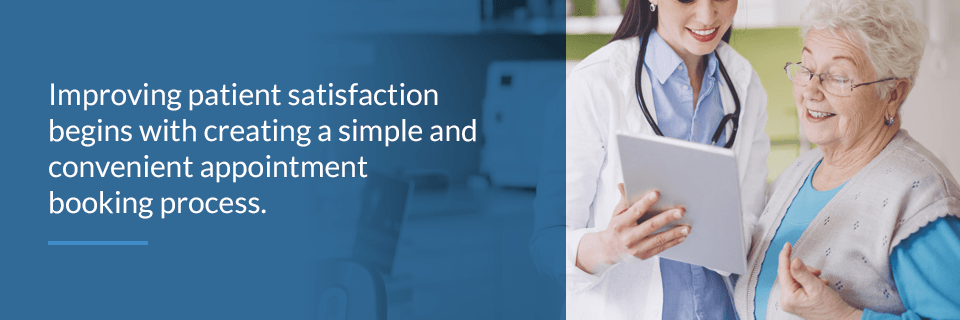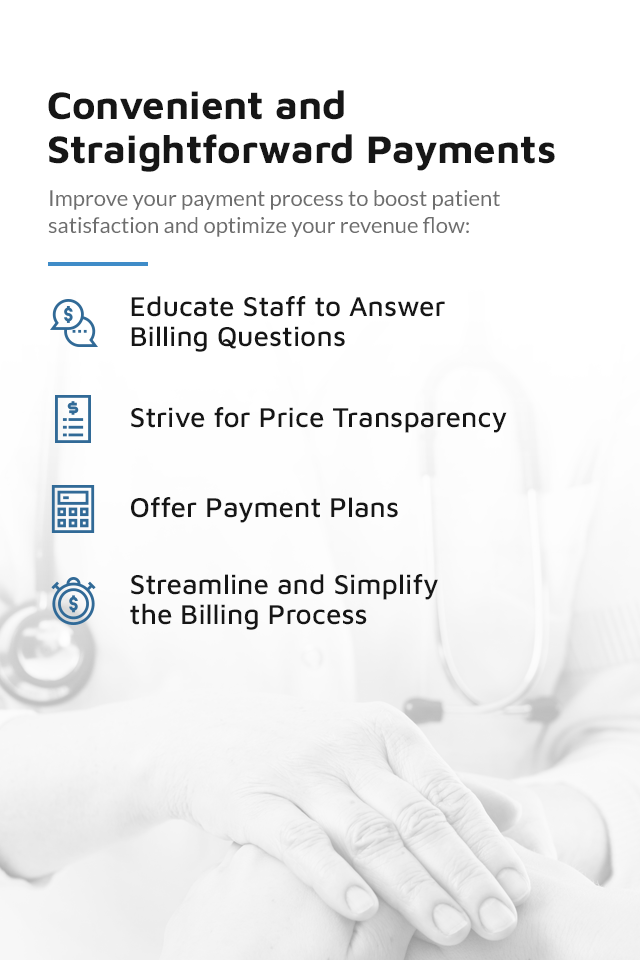Improving patient satisfaction has become an increasingly important goal for healthcare providers in recent years. In addition to keeping your patients happy and healthy, improving your patient satisfaction scores can also earn your practice a greater incentive payment under the Hospital Value-Based Purchasing (VBP) Program. The Hospital VBP Program rewards hospitals based on a score of their quality of care — and 25 percent of this score is based on patients experience of care.
When hospitals focus on improving patient satisfaction and experience, they can enjoy greater reimbursements that can then be used to further improve the quality of care they provide. However, the benefits of improving patient satisfaction extend far beyond quality scores and financial bonuses. Improved patient satisfaction is essential for building a strong patient-provider relationship and may even have a positive impact on your patients’ health.
Satisfied patients are more likely to make follow-up appointments and stick to their prescribed treatment plan, which can lead to more positive outcomes for them and increased patient retention for your practice. Happy patients are also more likely to return to your practice in the future, recommend your practice to their friends and pay their bills on time and in full.
How To Improve Patient Satisfaction
Patient satisfaction begins the first time a patient contacts your practice and continues until their bill is paid. When determining how to improve patient satisfaction, physicians and healthcare providers should keep this continuum of care in mind. Begin with your appointment booking process and then examine each step of the care process to identify areas where better care can be provided. In this piece, we will discuss several simple ways you can create a more caring, compassionate and patient-centric practice to boost your patient satisfaction and service quality.
Easy Appointment Booking
Improving patient satisfaction begins with creating a simple and convenient appointment booking process. Establish a booking system which allows patients to make appointments by whatever method they prefer, whether it is over the phone, via email, online or in person. Make sure your online appointment scheduling system looks professional and is easy to navigate. Your website may be the first impression some potential patients have of your practice, so provide ample resources and valuable tools. Strive to keep your phone lines open throughout the entire day, including during lunch hours. When answering phone calls, try to be prompt and avoid keeping your patients on hold longer than necessary.
After a patient has booked their appointment, send them a reminder about a week before with directions to reach your facility. This allows time for the patient to reschedule if necessary or contact your office with any questions they may have. If the patient is coming in for a surgery or more complicated procedure, be sure to provide any necessary instructions about how they should prepare for their appointment. Remember that a procedure which is routine for you may be confusing and possibly frightening for your patient. Ease their anxiety by providing a clear description of what they should expect on the day of their appointment.
Fast Appointment Check-in and Shorter Wait Time
When your patient arrives for their scheduled appointment, the front desk staff should greet them with a friendly face and help them check-in quickly. Patients should be directed to a waiting area and given an estimated wait time. As much as possible, try to stick to your appointment schedule and do not keep patients waiting longer than expected. If an emergency arises, be sure to inform patients of the situation and provide an updated wait time.
Long wait times can be a major source of frustration for your patients and can lead to poor patient feedback as well as poor scores on patient satisfaction surveys. However, often what makes patients unhappy is feeling they have been waiting a long time rather than the actual wait time. This is good news for hospitals as there are many measures you can take reduce perceived wait times, even when it is not possible to reduce actual wait times. Here are a few ways to reduce patients’ perceived wait time before an appointment:
- Provide explanations for long waits: Explained waits often feel shorter than unexplained waits, so keep your patients in the loop if an emergency arises or appointment runs longer than expected.
- Create a comfortable waiting area: Invest in comfortable seating and decorations that make your waiting room more pleasant. When patients feel more relaxed, they will not feel like they have been waiting as long.
- Reassure patients who appear anxious: If patients appear nervous or uncomfortable, front desk staff can offer reassurance and support. Wait times can feel very long when a patient is concerned about their appointment or procedure.
- Provide entertainment or activities: Give your patients something to keep them occupied, such as books, magazines or television. Even asking your patient to fill out forms while they wait can help reduce perceived wait time.
- Provide valuable service during the appointment: Another way to reduce perceived wait time is to provide exceptional value when the patient sees the physician. High-quality care will be well worth the wait.
By taking steps to reduce perceived wait time and give your patients a friendly welcome to your practice, you start on the right foot for better patient satisfaction.
Positive Interactions with Doctors and Staff
Perhaps the most critical factor influencing patient satisfaction is the quality of patients’ interactions with physicians and staff members. While providing high-quality care may seem more important than providing good customer service, the reality is many patients cannot accurately gauge the healthcare quality they are receiving. This means that even if exceptional care is provided, patients may still report low satisfaction if their interactions with doctors or staff were not positive. Luckily, physicians can easily improve patient satisfaction by following a few simple guidelines for better customer service and more compassionate care:
1. Improve Communication
Good communication begins when a patient contacts you to book their first appointment and continues throughout their entire relationship with your practice. In a service industry, all members of your staff must be committed to facilitating caring and respectful interactions with patients at every stage of their visit. Here are a few tips for improving patient communication with doctors, nurses and staff:
- Be clear and direct: Provide patients with clear directions and instructions during their visit. While administering care, inform patients about what you are doing throughout the procedure.
- Answer questions: Provide ample opportunities for patients to ask questions about their care and offer direct and thorough answers. Take time to make sure your patient understands their treatment before moving on to the next appointment.
- Initiate interactions: Staff should go out of their way to engage with patients and create positive interactions by greeting patients promptly when they arrive and pausing to assist patients who seem lost or confused.
- Stay in character: While providing care, staff and doctors should avoid holding conversations about their weekend plans or a new television show they like. Stay in character as a care provider and keep communication centered on the patient.
When communicating with your patients, never underestimate the power of a smile and friendly posture. Simply speaking in a caring and welcoming manner can help improve overall patient satisfaction with your practice.
2. Extend Time Spent with Your Patients
Patients who feel rushed during their appointment are much more likely to be dissatisfied with their care, especially if they waited a long time. A study of 1,486 ambulatory visits revealed patients were significantly less satisfied with their visit if they estimated that they spent less time with their physician than they expected. On the other hand, when patients estimated that they spent more time with their primary care provider than they had expected, their satisfaction increased significantly.
Longer appointment times may even be able to make up for long waiting times. A study of 2,444 visits showed a correlation between wait time, visit length and provider ratings. When visits were more than five minutes, provider ratings decreased by just 0.1 points for every 10 minutes of additional wait time, but when visits were five minutes or less, ratings decreased by 0.3 points for every 10-minute increase in wait time. By spending more valuable time with patients, you can improve patient satisfaction and build better patient-physician relationships.
3. Take a Seat and Use Eye Contact
Whenever possible, doctors should sit while talking to patients, especially if they are sharing a bad diagnosis. A survey showed that patients prefer doctors to sit while delivering bad news and view doctors as more compassionate if they do so. Sitting to talk to your patients can also increase their perceived visit time, which can, in turn, increase their visit satisfaction. A study of 234 patients revealed that patients overestimated time spent with physicians by 1.3 minutes on average when the physician was seated, but underestimated by 0.6 minutes when the physician remained standing.
Physicians and nurses should also make eye contact with patients as much as possible to show they are engaged and focused on the patient’s care. Avoid talking to patients while distracted by charts or while looking at x-rays. Offering eye contact while sharing bad news can also convey compassion and care.
4. Track Your Progress and Reward Success
When working to improve interactions with patients, be sure to keep your hospital staff accountable for providing excellent service. Use patient satisfaction surveys to track how happy your patients are with the quality of their interactions with staff and doctors. Acknowledge staff members who are excelling and address any problems you observe.
Under the Hospital VBP Program, patient experience of care is determined by a patient satisfaction survey, specifically the Hospital Consumer Assessment of Healthcare Providers and Systems (HCAHPS) survey. This standardized, national survey covers eight factors of hospital quality, including the quality of communication with nurses and doctors, how responsive the hospital staff was and if the patient feels they were treated with courtesy and respect. Practitioners can use these quality metrics as guidance for creating more positive relationships between patients, physicians and hospital staff, while also improving their practice’s VBP score.
Convenient and Straightforward Payments
Even if a patient has received excellent care and enjoyed their visit, a complicated or inconvenient billing process can still lead to dissatisfaction and a poor review of your practice. Patient frustration can arise from bills that arrive late, bills with charges they did not expect, bills with errors or an outdated payment process which makes it difficult for them to pay for their care. If a patient has a question about their bill, but your office cannot provide an answer, this can also lead to frustration and may make them less likely to pay their bill. Here are a few ways your practice can improve your payment process to boost patient satisfaction and optimize your revenue flow:
1. Educate Staff to Answer Billing Questions
When a patient contacts your practice with a question about their bill, someone in your office should be able to address their concern or connect them quickly to someone who can. Educate your front office staff to be able to answer patient questions about their charges, payment options and other general billing questions. You may even want to hire or designate a staff member to serve as a financial advocate who can assist your patients in understanding their charges or serve as a liaison to your third-party billing service.
2. Strive for Price Transparency
A major source of patient frustration is receiving surprise charges on their medical bills. Patients may have expected a service to be covered by their insurance provider, or they may simply be surprised by a cost that was much higher than anticipated. Offering tools that improve price transparency can help reduce these unpleasant surprises and empower patients to make educated decisions about their care.
Price transparency tools allow patients to get an idea of how much a procedure or treatment will cost before their visit. Patients should be able to access these resources on your website so they can better prepare for their medical expenses. Effective price transparency tools can also allow patients to compare different treatment options that offer quality care at different price points. Using these tools alongside payment plans can help patients choose quality care affordable for them.
3. Offer Payment Plans
Payment plans can significantly improve your patients’ satisfaction with your billing process by breaking expensive bills into manageable increments. With patients paying more and more out-of-pocket for their medical bills, payment plans have become a standard and expected option. Payment plans also provide peace of mind for patients and encourage them to receive the care they need regardless of the cost. This can lead to more positive health outcomes as well as greater patient satisfaction with their quality of care.
4. Streamline and Simplify the Billing Process
When you make it easy for your patients to pay their bill, they are more likely to pay on time, pay in full and be content with your services. Allow patients to pay their bills online so they can complete payments more quickly, which improves cash flow for your practice. Online billing services also allow you to send bills more efficiently and track payments more accurately.
Another essential aspect of offering a streamlined billing process is to ensure your bills are correct. Errors on hospital bills can be frustrating for patients who then need to jump through hoops to try to correct those errors. This stalls the payment process which inconveniences the patient and slows your practice’s revenue flow. Coding errors can also lead to compliance issues, causing even greater problems for your practice.
Working with a revenue cycle management (RCM) partner can help simplify your billing process for both your practice and your patients. When you outsource your medical billing, you can focus on providing excellent care while your RCM partner ensures your patients receive accurate bills promptly. Your third-party billing partner can process and track payments efficiently to improve cash flow, minimize billing denials and streamline the payment process for your patients.
Accessible Resources and Education
The cherry on the top of excellent patient care is providing valuable resources and education about procedures, treatments and medical conditions. The last thing you want is for your patients to get home after an appointment and start searching online for answers about their condition that you neglected to provide during their visit. The patient may discover incorrect advice or fail to follow the right recovery practices.
When discharging patients, remember that medical information which is old news to you may be entirely new for your patients. Address any questions your patients may have about their symptoms or treatment with patience and compassion. Provide patients with all the resources they need for a healthy recovery, even if the information seems common sense to you.
Offer resources to patients on the day of their appointment, as well as directing them to resources available on your website. When patients continue to interact with your practice online, this fosters a long-term relationship and greater trust in your practice.
Patient education is also a dimension of the HCAHPS survey of patient experience of care. Patients completing this satisfaction survey are asked if the staff offered explanations about medicine, told them what medicines were for and described any possible side effects before administering the medicine. The survey also asks about the information provided when they were discharged, including what they should do during recovery and any symptoms to watch for. Patient satisfaction scores also reflect the patient’s care transition, which is evaluated by how well the patient understood their care when they left the hospital.
By providing accessible resources and clear education to patients, care providers can improve their patient satisfaction scores as well as providing better overall care to patients.
Improving Patient Satisfaction By Simplifying Your Billing Process
Improving patient satisfaction can benefit the overall health of your practice by increasing patient retention, accelerating revenue flow and improving patient health. Satisfied patients lead to positive reviews and improved quality scores, which helps your practice grow and thrive.
If you want to improve patient satisfaction in your hospital or private practice, Healthcare Administrative Partners can help by providing streamlined billing, clinical analytics and accurate coding for radiology and other specialties. As your RCM partner, Healthcare Administrative Partners offers comprehensive solutions to simplify your payment process for your practice and your patients. Because we are experts in the field, we can eliminate billing errors to reduce payment processing time and improve cash flow.
By optimizing your medical billing process, you can enjoy maximum reimbursements and reduced administrative expenses, while improving your patients’ satisfaction from start to finish. Contact Healthcare Administrative Partners to learn more about our complete revenue cycle management services.









